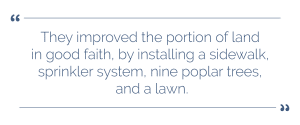

Updated on September 26, 2023
Imagine, for several years, you have been living at your home unbothered, comfortably utilizing and performing upgrades to the land. Suddenly, your neighbor has a land survey done, they learn that part of the land you have been using is within their lot, and they want you to cease using something like your driveway immediately, and/or cover the costs of undoing everything. While it may sound like they could be entitled to their request, we will explain how obtaining a prescriptive easement could help, while describing an actual case example.
It is possible to get a prescriptive easement even if you did not know you were using your neighbor’s property. This is because prescriptive easements are based on the principle of adverse possession, which means that you can acquire a legal interest in another person’s property if you use it openly and notoriously for a certain period of time without the owner’s permission. A key difference between a prescriptive easement and adverse possession is that by way of a prescriptive easement you only get the non-exclusive right to use the land of another, whereas with adverse possession you get actual ownership. But, adverse possession requires the payment of taxes, while a prescriptive easement does not.
In order to establish a prescriptive easement, you must meet the following requirements:

The law is clear that use is adverse even if the claimant used the property under the mistaken belief that she is the owner of the property. (Gilardi v. Hallam (1981) 30 Cal.3d 317, 326.) Therefore, innocent use of another’s land does not defeat a finding of hostile possession. (See Applegate v. Ota, 146 Cal.App.3d at 710–11 [“[A] person who uses the land of another mistakenly does not have a greater burden to establish a prescriptive easement than does one who enters the land of another intending to be hostile to the title of the true owner.”)].)
In Gilardi, the Supreme Court of California held that a good faith improver of land may be entitled to prescriptive easement, even if the improver does not meet all of the traditional requirements for adverse possession.
Defendants mistakenly believed that a portion of their neighbor’s property was part of their own property. They improved the portion of land in good faith, by installing a sidewalk, sprinkler system, nine poplar trees, and a lawn. The plaintiffs, the owners of the property, were aware of the improvements, but did not object.
After several years, the plaintiffs discovered that the defendants had encroached on their property. They demanded that the defendants remove the improvements, but the defendants refused. The plaintiffs then filed a lawsuit to quiet title to their property.
The trial court found in favor of the plaintiffs and ordered the defendants to remove the improvements.
However, the Supreme Court of California reversed the trial court’s decision. The Supreme Court held that the defendants may be entitled to relief, such as an easement over the disputed portion of land, even though they did not meet all of the traditional requirements for adverse possession.
The Supreme Court reasoned that the defendants were good faith improvers of the land, and that the plaintiffs were aware of the improvements but did not object. The Supreme Court also found that the plaintiffs would not be unduly prejudiced if the defendants were allowed to keep the improvements. “The stipulated facts in the instant case establish that defendants and their predecessors took possession of the disputed land mistakenly believing they were the owners. There are no additional facts expressly or impliedly showing that they recognized the potential claim of the record owners or that they intended to renounce their claim if they did not have record title. The trial court finding that they did not intend to claim any land that did not belong to them is not supported by the record. Under the stipulated facts, their possession was hostile and adverse.” (Gilardi v. Hallam (1981) 30 Cal.3d 317, 326.)
The Supreme Court remanded the case to the trial court to determine whether the defendants were entitled to relief.
If you believe that you have a prescriptive easement claim against your neighbor, you should reach out to experienced real estate counsel who are well versed in easement disputes such as the one described above. Our experienced easement attorneys in Los Angeles have encountered complex scenarios like this across the state and can assist with your dispute and provide you with counsel on your easement issue. Our attorneys at Schorr Law look forward the challenge. Schedule a consultation with one of our Top Rated California Real estate attorneys today. You can call us directly at (310) 954-1877, text us at (310) 706-2265, or send us a message here.